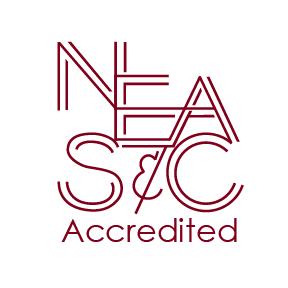With Challenge Comes Opportunity
Issue date:2020-03-16Wolfgang Soeldner is the Deputy Dean of Educational Technology who is responsible for making sure all systems and platforms of UWC Changshu China are optimised to enhance and support teaching and learning across all departments in the school. At the moment, Wofgang and his team's priority is to ensure the smooth running of the Distance Learning Program by digitally supporting all members of our community to have access (as best possible) to all they need to be successful in an online world. Below Wolfgang and some teachers share their experience in distance learning.
Although a difficult time for the world at large, UWC Changshu China has reacted in a very positive and progressive way by tackling the problem of continuous, quality teaching and learning during a period lacking the physical teaching space and in-person contact. It has been four weeks since we began our Distance Learning Program and we have received some positive feedback as well constructive suggestions. UWC Changshu China is a great example of how Distance Learning can serve a community with students and staff from all over the world.
1. Pedagogical under pinnings of Distance Learning Program(DLP)
The UWC Changshu China DLP aspires to be a rigorous academic and pastoral program designed to accommodate the lack of the physical presence of students and faculty at school. With the support of technology, faculty are encouraged to be creative, with the goal of cultivating engaging, student-centered learning that is personalized in a remote environment. Meanwhile, students are expected to take ownership of their leaning, record evidence of their learning in their learning portfolio and continue to engage with their peers and their local community.
Faculty members are encouraged to employ methods of “flipped” instruction and utilize realtime streaming to allow for online interactive learning experiences. “Flipped” instruction reverses the traditional approach of teachers lecturing in class and assigning homework tasks for outside the classroom. Instead, instructional content is delivered outside class in the form of pre-recorded videos, presentations, and a wide range of other digital resources, while students engage in hands-on interactive learning activities especially designed to consolidate and extend their learning during class time (in our case, in a Virtual Learning Environment on Microsoft Teams).
Alison King, one of the first scholars to introduce methods of flipped instruction, explains, the teacher “must move away from being the one who has all the answers and does most of the talking toward being a facilitator who orchestrates the context, provides resources, and poses questions to stimulate students to think up their own answers (King, 1993).” Meanwhile, the complex global challenges we currently face further remind us that we must cultivate UWC students who are knowledge creators and problem-solvers in the 21st century.
We have long since been in an era of hugely varying learning styles and needs. Although conventional teaching practices continue to play a prominent part in the way we teach. Flipped instruction in a Virtual Learning Environment (VLE), with utilization of educational technology, presents a good opportunity to:
Promote learner agency
Enable more personalized learning
Encourage students to take ownership of their learning at their chosen pace
Stimulate students to explore a wide range of resources
Cultivate peer learning in an online environment
Develop digital literacy skills among students
Help support the development of self-management skills and resilience
For faculty, the program creates valuable collaboration opportunities with other faculty in the development of digital resources. Professional learning also continues in the form of reflection and sharing in respective Professional Learning Communities (PLC).
Upcoming IB deadlines, time zone and technical difficulties present obvious challenges. A range of digital feedback channels are in place to collect as much feedback from faculty, students and parents as possible during the program. Meanwhile, students’ pastoral needs are addressed through the existing advisory structure, where each advisor maintains regular check-ins with their group of 7-8 advisees.
2. DLP Program Structure & the Role of Education Technology
With our digital systems and platforms (i.e. ManageBac, Microsoft Teams and iSAMS) our school has been able to continue providing an excellent, student-centred program of education.
The mix between synchronous and asynchronous lessons gives students both the chance to interact with each other and teacher in a live environment, as well as providing the opportunity to learn at their own pace, in their own style. Synchronous live interactions consist of small or large group guided inquiry on Microsoft Teams. All synchronous interactions are recorded for later viewing for students in different time zones. Meanwhile, Asynchronous learning consists of guided exploration, consolidation work, or formative assignments. See Foundation Program Peace and Sustainable Future subject sample below:
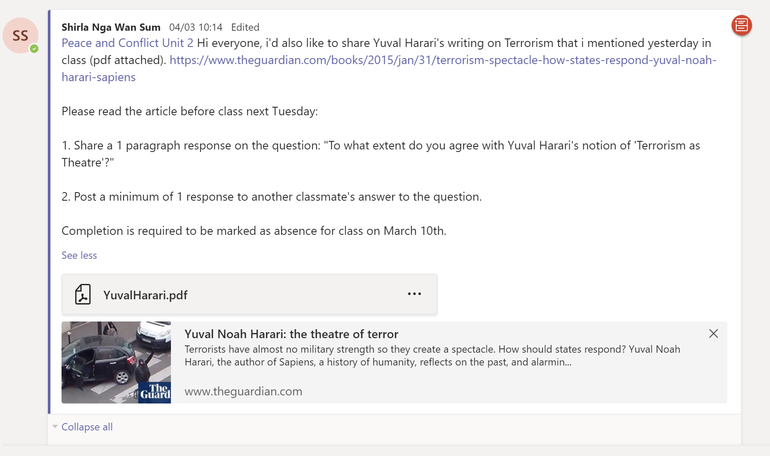
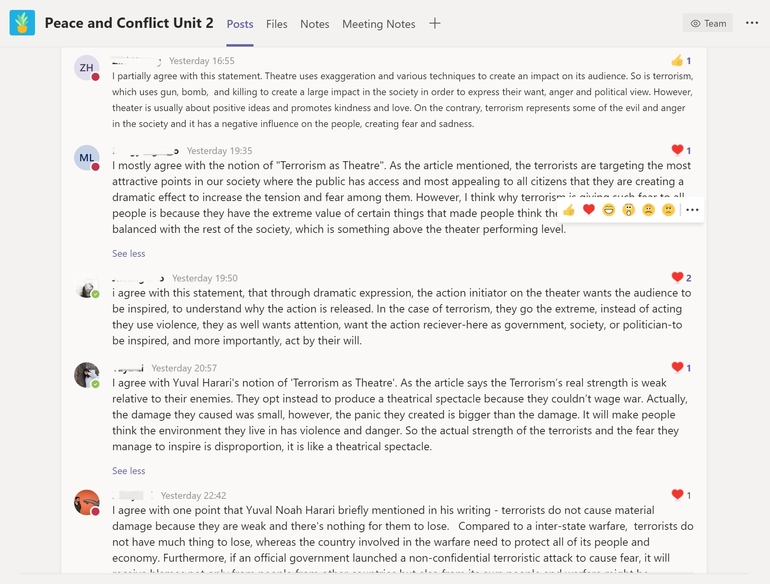
3. Examples of best practice at UWC Changshu China
Peer Feedback and Reflection with Michael, English Teacher
“In my English classes, I emphasize that what students learn from each other is more important than what they learn from me. I have found Microsoft Teams to be an ideal platform for students to give each other feedback, both in writing and in live video meetings. For example, earlier this week I scheduled “Peer Feedback and Reflection” meetings for my DP1 Language & Literature students. Before each meeting, pairs of students posted their recently submitted essay draft, read their partner’s draft, and gave feedback using a “peer evaluation form” that I had prepared. During the live meeting, each pair of students shared more in-depth feedback orally and asked follow-up questions to each other. Then, I facilitated a reflection by asking them what they learned from each other and from the revision process. Only after this reflection did I provide my own feedback on their drafts.
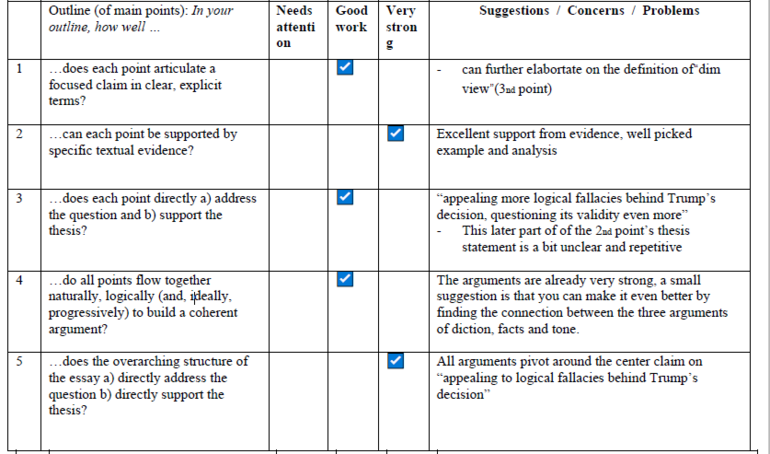
I was impressed by how thoughtful the students’ feedback and reflections were. By the end, I felt that they not only learned from the feedback others gave them, but also from the process of giving meaningful feedback to others.”
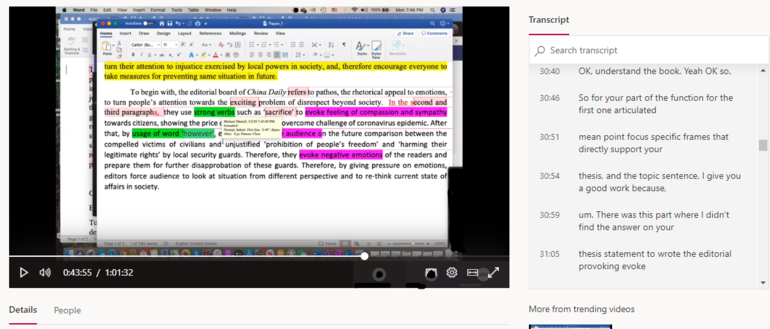
Synchronous teaching with formative assignment with Christoph, Music Teacher
“In my Music and Theory of Knowledge classes, I place an emphasis on personal and live interactions in order to engage students as much as possible. I set them certain listening or analysis tasks and then we discuss in our live meetings. Sometimes I will ask students to upload written responses to ManageBac in order to prepare them for the upcoming mock and final exams. With my FP music class, we did short analysis and composition tasks where I gave individual, personalised feedback. Right now, students have started to work on their second major composition this year and I provided individual feedback.”
Experiential and collaborative learning with Kaya, Enghlish Teacher
“This task was assigned after a series of reading comprehension and vocabulary building activities related to food safety and health. Students are asked to film themselves cooking while describing the necessary ingredients and the cooking process. The initial purpose was to have students take a break from sitting in front of their computers and do something fun that involves physical movements and speaking practice, which needed to be emphasized as the opportunity of speaking English is limited while they are at home. Their response was generally positive and many of the students put a lot of work into this task and I was impressed by the quality of their work. As a follow-up activity, students watched their peers' videos and posted comments on Teams. They were also amused by their classmates' creativity and cooking skills. A few students had difficulty uploading their video on Teams but they managed to send it to me through other means so I could upload it for them.”

Using technology to overcome "distance" in distance learning with Juan, Mathematics Teacher
"In many of the educational videos on the subject of Mathematics, the teacher/professor is not seen at all, if seen, it is always on the process of writing on a big board. It is in the nature of Mathematics, symbols, diagrams, expressions… they need to be seen and written, not merely spoken. The use of a document camera that shows students my writing at the same time that I explain was, in a way, natural. My students did not have to adjust to a different learning style, the big board has been reduced to an A4 size mini white board but that’s it. In real time, like in a normal lesson in a classroom, they can ask a question, ask me to go back or add an extra explanation of certain steps."

Using systems-thinking in Geography with Cassandra, Geography Teacher
In FP Geography we have been exploring the Geographies of Freshwater. By using a systems-thinking approach, students are able to examine the multiple physical and human processes that create physical formations within a drainage basin. To demonstrate learning, students were tasked to design and build a model of a drainage basin to show physical formations in the upper, middle and lower course of the river. This task allowed students to visualise the river system as whole, apply their learning in a practical way and reduce the number of hours spent on the computer for the learning module. At the end, students shared photographs, videos, and presentations of their models in our online digital classroom. Despite students being advised to spend a limited length of time on the task, the students had so much passion they far exceeded this. Using limited materials available at home, students showed outstanding creativity in their model-making. Using any items they could find, from vegetables, to clothes, to toys from their younger siblings, the students demonstrated both knowledge and understanding of the drainage system and passion for creative learning!
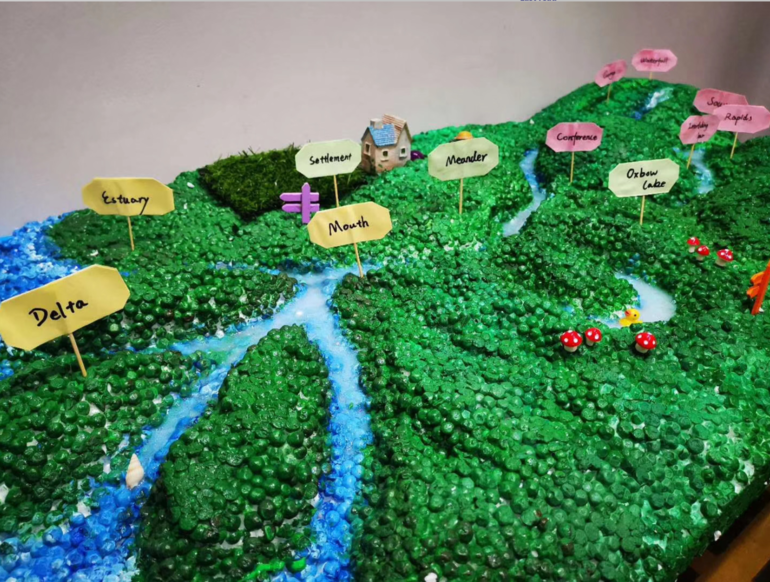
Contextualized, place-based art education with Huang Ting, Visual Art Teacher
“The challenge of virtual classesfor Visual Arts is lacking materials and working spaces at home. Students cannot keep on working on their unfinished piecesin the previous project, so, a digital project was planned to take place and solve the problem for the most part. In the unit ‘Culture and Places’, students explore their surroundings, such as environment, culture, and social issues, then develop deeper understanding of the relationship between people and places, also having a chance to explore and practice digital skills. The ‘contact sheet’ task is my favourite part of this digital project. It allows students to look at their surroundings which they previously have never carefully looked at with intention. They needto explore the connection between people and places to express the irinsightful thoughts and moving emotions. Especially duringthis epidemic period, some students are not allowed to go out for photo shooting. They then change their perspective on objectsat home and people’s life after the outbreak of coronavirus. It isreally good to see all of them take pictures not merely of a beautiful scene, but also with good consideration of visual elements, photo techniques, and emotion expression.”
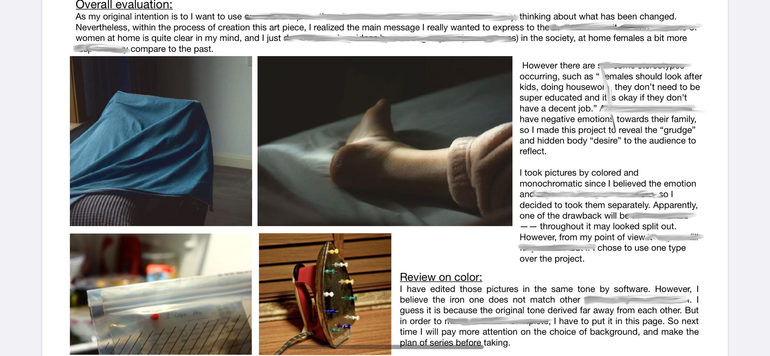
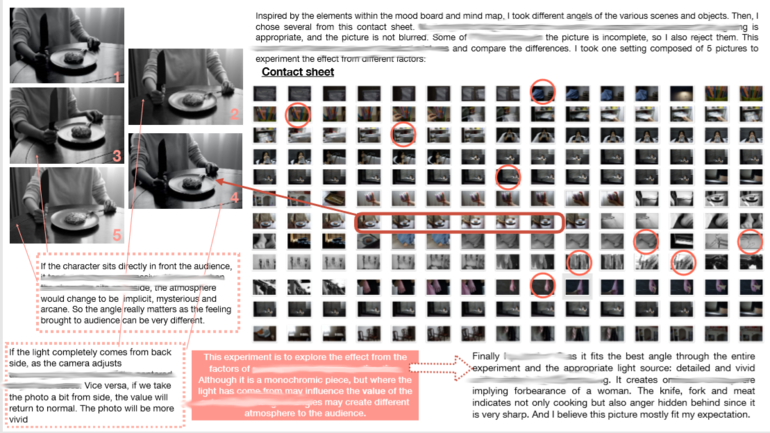
Fostering Student Agency with Dr. Reza, Biology Teacher
“The idea of flipped classroom was my professional learning goal this year. However, due to insufficient preparation time, I did not start that mission until now. With flipped classroom, it is not only my responsibility, but also the students’ responsibility to prepare for class. This current distant learning program provided the golden opportunity to find out the pros and cons about this flipped classroom project and it has beena really successful experience! I realized that my students have a better opportunity to think and digest the content of my videos at their own. I have gotten positive feedback from my students and in our live class interactions, I see how much they have learned.”
Every situation, whether bad or good, has two sides and in our case with the physical closure of our campus, it has provided our community with a valuable opportunity to create and establish ourselves in the virtual world. Throughout this period of distance learning, UWC Changshu China and the rest of the UWC movement have truly impressed and inspired me as we pull together in support and guidance. As per UWC's mission and values, we are tackling this difficult situation by sharing mutual responsibility, respect and overcoming daily personal challenges with resilience.
I hope you can join me in showing great appreciation towards our wonderful community:teachers, students, administrators, staff and of course, parents.











